More Guitar Amps
We will be presenting our pick for the best jazz amps. We understand that value-for-money and budget are also criteria for selection. As always, our opinion is, well, just ours and purely subjective. Play and select your ideal one before reaching for the wallet. You might prefer something different. There is a penchant for clean-sounding guitar amps in the realm of jazz. Unless you are searching for intergalactic jazz-fusion, like The Mahavishnu Orchestra era John McLaughlin tone, the chances are that all you will prefer is a clean channel, probably, a hint of the chorus effect along with some other clean modulations. A clean signal preserves the harmonic tonal character – as noted by many jazz guitarists. Certain amplifiers are wildly popular among jazz enthusiasts. Among our list, the Fender Blues Junior III is particularly preferred for its warm tonal output. Non-Fender brands like the Roland JC40 are also favored. The Fender Frontman 10G is the ideal choice for an affordable jazz amplifier.
BEST JAZZ AMPS – Comparing table
Table of Contents
| Image | Product | |
|---|---|---|
BIG ON FEATURES, SMALL ON BUDGET 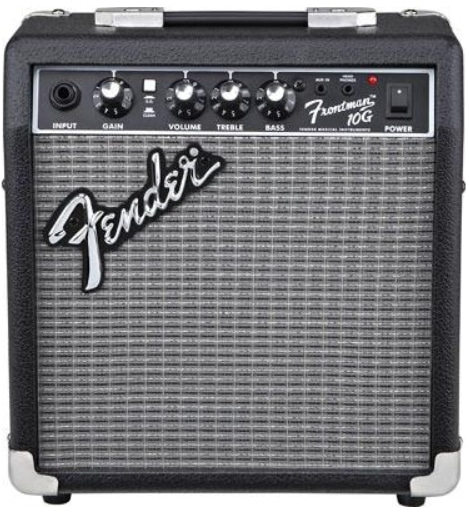
| Fender Frontman 10G
| Check Price |
DISTINCT WARM CLARITY FAVORED BY THE PROS 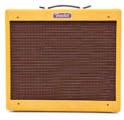
| Fender Blues Junior III
| Check Price |
GREAT CHOICE FOR MODERN JAZZ PLAYERS 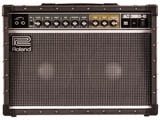
| Roland JC-40 Jazz Chorus
| Check Price |
BEST ALL-IN-ONE TUBE SOUND FOR CLASSIC ROCK, BLUES, AND JAZZ 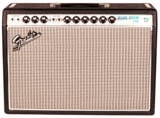
| Fender '68 Custom Deluxe Reverb
| Check Price |
VINTAGE AMPLIFICATION FOR THE BRIT-INVASION SOUND 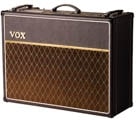
| Vox AC30
| Check Price |
RELIABLE CLASSIC FOR BLUES, COUNTRY, AND ROCK 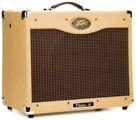
| Peavey Classic 30
| Check Price |
AN INSTANT JAZZ HIT AMONG THE YOUNG AND OLD 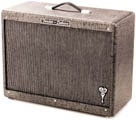
| Fender George Benson Hot Rod Deluxe
| Check Price |
LOTS OF OPTIONS IN A SMALL PACKAGE 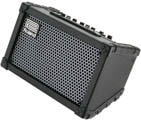
| Roland Cube Street
| Check Price |
Best choice headphone amp with jazz solo tone 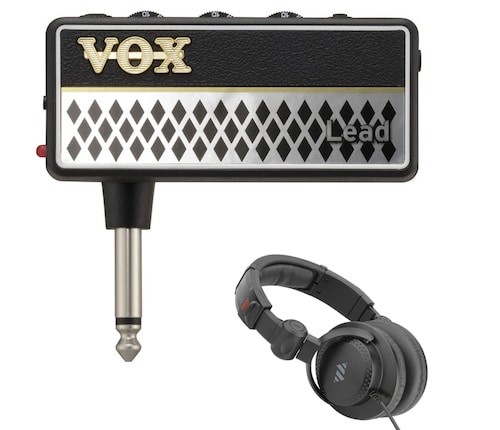
| VOX Amplug 2 Lead
| Check Price |
Fender Frontman 10G – Tiny Fender with a captivating sound
The 10 Watt solid-state Fender Frontman is the perfect choice for home practice or casual jams. The single-channel amp pumps through a specially designed 6” Fender speaker. Easy-to-use controls, a 2-Band EQ, overdrive switch, aux input, and headphone output – Fender has made it sure that the Frontman serves the working man’s practice routine with negligible fuss.
Sound Performance
The Frontman is aimed at the budget-conscious beginner or working-class musicians. It does its job exceedingly well and provides a tiny bit of distortion through the overdrive switch if you feel like it. The output level may surprise you, though high levels may result in a loss of bass and tonal depth. “Bass” and “Treble” provide the necessary EQ shit that you might need. Overall the amp is a versatile choice for a variety of genres.
Design Specifications
- Wattage & Type: 10W, solid-state combo.
- Input channels: 1.
- Line-outs: Headphone out.
- Weight: Approx 8.5 lbs.
Pros
- Cheap, well-built, reliable product from the house of Fender.
- 10W power pumped through a 6” Fender Special Design SPeaker.
- Lightweight and portable – ideal for moving around.
- 2-band eq, overdrive- ready to rock it out.
- Aux input, headphone out – ideal for home practice.
Cons
- An added channel would have been nice – with options to change between the clean and the gain tone.
- Single overdrive effect.
- Primarily mean for self-practice – the output can get drowned by drums.
- Not at all suitable for gigs.
- Absence of modulation, reverb/delay effects.
- Non-programmable. No presets.
Recommended: Yes, affordable choice for the beginners. It is ideal for silent home practice.
To check the current price of Fender Frontman 10G, click here.
Fender Blues Junior III – Vintage amp revered by countless greats
The Fender Blues Junior is revered in the jazz and blues circle for its beautiful warm sound. The 15 W tube amp delivers a remarkable power through the 50W “Lightning-Bolt” speaker. In live situations, the sound volume is easy to manage due to its low wattage. Its single speaker output makes micing a breeze.
Sound Performance
A warm, overdriven Fender-y sound is the characteristic output of the Fender Blues Junior III. Like all classic Fender amps, the clean channel produces a loud, clear output with a beefy midrange. In case you need a little boost, hit up the “Fat” switch for an immediate push in the preamp circuit. The Fender Jazz amp also has an excellent lush reverb, courtesy of the Fender Spring reverb, and the Sparkle mod.
Design Specifications
- Wattage and type: 15W, Tube Combo amp.
- Input: 1.
- Effects Loop: External Speaker jack.
- Weight: 31lbs.
Pros
- 15W of all-tube amp power drives a 50W “Lightning Bolt” speaker by Eminence.
- Rattle proof shock absorbers ensure the longevity of the inner tube circuitry.
- Silky smooth tonal palette with Sparkle mod, Fat Switch, and the Fender spring reverb.
- Affordable Fender sound at much lower prices.
- Lightweight compared to other 1X12”- ideal for gigs.
Cons
- Not fit for multiple genres.
- Loud amp, but lesser gain than Fender Hot-Rods.
- The mid eq does not function as well as expected.
- The amp buildup quality could be improved.
- Limited modulation options and no standby switch.
Recommended: Yes, for the regular touring jazz musician, as well as for home.
To check the current price of Fender Blues Junior III, click here.
Roland JC-40 Jazz Chorus – Crystal clear, clean tone in a classic solid-state combo
There was a considerate buzz when the 40W variant of the iconic Roland JC-120 came into the market. The solid-state amp pumps 40 W of power through the 2×10” speakers- delivering the famed stereo sound of the Jazz Chorus series. With options for footswitch programming, a rear-side effects loop- the JC40 is truly built for old and modern players alike.
Sound Performance
Loaded with several of Roland’s classic effects, the JC-40 provides a true stereo sound output. The solid-state digital circuitry promises better longevity. Use a stereo pedal effect, or top it up with modulation to feel the elusive signature chime. Among the built-in onboard effects, you find Roland’s famous Dimensional Space Chorus. You will also find a vibrato, distortion, and reverb effects designed for modern players.
Design Specifications
- Wattage and type: 2×20 Watts, Solid State Digital Combo amp.
- Input: 2 Stereo.
- Effects Loop: External stereo effects loop.
- Weight: 35 lbs(appx).
Pros
- True stereo high-quality punchy output with excellent tone.
- Programmable stereo effects loop for processors, modelers, and synths.
- 3D sound effect with the Dimensional Space Chorus, an overall clean output.
- Well built sturdy construction for longevity.
- 2x20W= 40 W separate power amp drives 2 custom-designed 10” speakers.
Cons
- Not the best distortion available in the market.
- Not the loudest amp of the lot.
- A bit expensive.
- Added footswitch socket would have been great.
- Some users complain that the amp is excessively bright.
Recommended: Yes, if you are looking for the famous Jazz chorus sound, or a clean overall bright sound – with articulation.
To check the current price of Roland JC-40, click here.
Fender 68 Custom Princeton Reverb – Legendary solid-state reliability for ages
Fender is known for its guitars, but they also make great amplifiers. The Fender 68 Custom Princeton Reverb is one of the amps. It has a ton of superb features for any jazz guitar player.
Description
This amp takes you back to the old “silver face” Fender amps of the 1960s. it looks great and has a classic look to it. The detailing on the amplifier is amazing. The amp is all-tube with 6V6 power tubes. It has a 12″ Celestion G12V-70 speaker that produces excellent tones. You get 22 watts of power. There is both a custom and a vintage channel. It’s suited for all types of guitar playing including jazz. The vintage channel produces great reverb tones while the custom channel has a fatter “Fender Bassman” style tone to it. Both the channels have reverb and vibrato effects. The amp comes with a footswitch. You also get the standard volume, treble, and bass EQ settings. You’ll find speed and intensity settings for the reverb.
Specs
- 22 watts
- Reverb and vibrato
- Vintage and custom channel
- Tube driven
- Celestion speaker
Pros
- Lots of versatility
- Produces more than jazz tones
- Amazing reverb sounds
Cons
- Quite expensive
- Could use more wattage
Who is it Suited For?
This amp is suited for any player looking for solid jazz tones. It’s ideal for intermediate or professionals. It’s expensive, so it’s not the best choice for beginners unless you have a large pocketbook. If you need exceptional clean tones and high-quality reverb, this is the amp for you.
Conclusion
The Fender 68 Custom Princeton Reverb is a tone machine and the perfect amp for jazz guitar. It’s not a cheap amp but don’t let the price get you down. The amp produces great clean tones and has that famous fender reverb we all love. You get two great channels that add to the versatility of the amp. It could use a few more watts, but it’s dependable and has the tones you need. The Fender 68 Custom Princeton Reverb is a recommended amplifier.
To check the current price of Fender 68 Custom Princeton Reverb, click here.
Vox AC30 – Perfection and versatility in a single amp
The Vox AC30 is a versatile amp that can help you play jazz guitar, but it’ also suited to many other guitar styles. This amp has a lot of features for today’s modern guitar player.
Description
The VOX AC30 gives you both a top boost and a normal channel. The top boost features treble and bass controls. You can get everything from a clean sound to good overdrive with this channel. If you want just a clean tone, use the normal channel. The amp also comes with tremolo and reverb built-in. You get 30 watts of power so the amp can perform at smaller gigs. The amp is powered by two 12” Celestion Greenback speakers which sound great and produce plenty of great guitar sounds. The amp can produce classic British Invasion sounds all the way up to modern sounds, and it’s great for jazz as well. You can add effects via the effects loop for even more tonal variations. It’s all powered by 12AX7 and EL84 tubes, so you get those vintage tube tones that you want.
Specs
- 30 watts
- 2 channels
- Tremolo and reverb effects
- Footswitch
- Bypass effects loop
- Jack for external speaker
Pros
- Two channels
- Reverb and tremolo effects built-in
- Can hook up to external speakers
- 30 watts for larger gigs
- A lot of tonal variations possible
Cons
- Very expensive for a 30-watt amp
Who is it Suited For?
This amp is perfect for both beginners and seasoned professionals. You can get a wide range of tones out of it, and the controls aren’t complex, unlike similar amps. It’s also perfect for those that want to play gigs as it has enough power with 30 watts for that purpose.
Conclusion
The Vox AC30 is a great sounding amp that has two channels for lots of versatility. It’s all powered by tubes, so you get the vintage tones that you want. It’s suitable for many forms of music, including jazz guitar. The Vox AC 30 is a well-rounded amp and highly recommended.
To check the current price of Vox AC30, click here.
Peavey Classic 30 – Trustworthy all-tube versatility that’s built to last
Peavey makes solid amplifiers and the Peavey Classic 30 has what you need to sound great. It’s a low-cost amp for anyone that wants to play jazz or other guitar styles.
Description
The Peavey Classic 30 gives you 30 watts of power, and many gigging musicians love this amp for all tier gigs due to all the sounds you can get out of it. The amp is powered by 12AX& and EL84 tubes, so you get great vintage sounds out of it. You also get spring reverb that helps your jazz lines come alive. You get two channels, and bot of these can be controlled via a footswitch. The clean channel sounds smooth, and you get ice gain in the lead channel with a boost function. It can play country, rock, blues, and jazz styles with ease. Dial-in the controls to the right level for the sounds you want.
Specs
- 30 watts
- Tube powered
- Spring reverb
- Footswitch
- 2 channels
Pros
- Two channels
- Great spring reverb
- Two channels for many tonal options
- 30 watts for larger gigs
- Controllable via a footswitch
Cons
- Could use better distortion
Who is it Suited For?
The Peavey Classic 30 is well suited for anyone looking to play jazz or other styles. It’s not a metal amplifier, but it’s fine for many other styles where hard distortion isn’t needed. The clean channel sounds great, and it has good overdrive. It’s perfect for gigging musicians as the 30 watts is powerful enough for many venues.
Conclusion
You can’t go wrong with the Peavey Classic 30. This is a tube-powered map that produces a ton of great guitar tones. It has reverb, and it’s suitable for many jazz styles. The channels give you lot of versatility, and you control it with a footswitch. The Peavey Classic 30 is a recommended amp for jazz guitar.
To check the current price of Peavey Classic 30, click here.
Fender George Benson Hot Rod Deluxe – Classic combo specially tailored for jazz
For professionals looking for a gigging jazz style amplifier, the Fender George Benson has all the features you need to make amazing jazz music.
Description
The Fender George Benson s a powerhouse jazz amp with 40 watts of power. This means the map is perfect for professional gigs where you need to be heard over the drums. It’s been created in collaboration with guitar great George Benson. It’s powered by a Jenson C12K speaker, 12AX7, and 12AT7 tubes. You get great tonal range, clarity, and superb sound for jazz as well as many other styles. This amp has three channels so you have many options in terms of sounds that the amp can produce. The channels are clean, drive, and more drive. You also get a 2 button footswitch to control your amp. It also comes with reverb to spice up your jazz playing. You can hook up pedal to it with the effects loop to expand the sounds you can get out of this exceptional amp.
Specs
- 40 watts
- Tube driven
- 3 channels
- Reverb
- Effects loop
- Footswitch
Pros
- Professional jazz tones
- Signature model (George Benson)
- Reverb
- 3 channels
- 40 watts
- Footswitch and effects loop
Cons
- A little expensive
- Can only buy in USA (no international sales)
Who is it Suited For?
This amp is best suited for professional players looking to do some gigging. The 40 watts gives you enough power for most gigs. Beginners might find that this amp has a little bit too much for them. It’s suitable for any intermediate or pro player that is looking for an amp to take them to the next level in their playing.
Conclusion
The Fender George Benson is a high-performance professional amplifier. It can produce a ton of tones and not just jazz. Fender George Benson has three big channels so you can ado a lot with this amp that you can’t with other amps in this price range. It comes with that famous Fender reverb and sounds amazing. This is the perfect jazz amp for the seasoned professional.
To check the current price of Fender George Benson, click here.
Roland Cube Street – All in one versatility
When you’re on the go all the time, you don’t want to lug around a heavy amp as this is not practical. You may have a jazz rehearsal to go to or just want to jam with friends. The Roland Cube Street makes this easy, and it has a lot packed into one small package.
Description
Roland Cube Street has 5 watts of power, but it sounds big for its size. This small package can do a lot for you. It runs on batteries, so it’s perfect for the beach, camping, or a practice session. It’s a solid-state amp but sounds great. You get a built-in tuner, eight amp models, and onboard effects like delay, flanger, phaser, chorus, and reverb. There is a stereo in jack to hook it up to other electronics. It produces a wide range of tones in such a small package
Specs
- 5 watts
- Eight amp models
- Built-in tuner
- Onboard effects
Pros
- Different effects
- Eight amp models
- Portable unit
- Runs on batteries
- Sounds good for its size
Cons
- Lacks power for gigs
- Effects can be confusing for beginners
Who is Suited For?
The best part about this amp is that it’s suitable for anyone. It’s portable so you can take your jazz with you. The amp is lightweight so you can go to the beach with it or to your rehearsal. It has a wide range of good tones and authentic-sounding amp models. You get a tuner and common effects built right in. Roland Cube Street is the perfect amp for jamming and a recommended product.
To check the current price of Roland Cube Street, click here.
BEST Jazz Amps Buying Guide
You have several things to consider before you buy jazz guitar amps. Since you’re playing a unique style of music, you may want A specific amp for this purpose. There are many cheap amps on the market that are suitable for playing jazz, or you can spend a whole lot of money on your amplifier. Many of these amplifiers are lightweight, and you can carry them around with you to practice sessions. You will find great jazz tube amplifiers as well as solid-state amplifiers for playing this form of music. Let’s have a look at some of the things you need to consider before you buy.
Tube Amps Vs. Solid-State Amps for Playing Jazz
Whether you pick a tube amplifier or a solid-state amplifier is all down to a matter of preference. Both these amplifiers sound great for playing jazz music; it all depends upon the amplifier mode that you pick for playing jazz music. For example, the Fender Blues Junior III is a great amplifier for playing jazz guitar, and it’s a tube amplifier.
Tube Amps
One of the main advantages of tube amplifiers is that they have a unique sound. Most guitar players enjoy the sound of tube amplifiers because they use vacuum tubes to produce the sound. They don’t rely on digital technologies to create the right tone. Tube amplifiers do tend to cost more, but they can be well worth it, especially when it comes to playing jazz.
The main reason you would want to go with a tube amplifier is that they produce excellent clean tones. Since jazz is a music that is most associated with clean playing a good tube amplifier is going to be a reliable investment for you. If you want vintage-sounding it clean tones, then a tube amplifier is the better solution when you compare it to a solid-state amplifier.
If you plan on recording your jazz music then a tube amplifier it’s probably going to be the right choice since you’re going to want the best tone possible for the recording. please keep in mind that was tube amplifiers you have the added expense of buying additional tubes when the ones you have burned out so that might be something that you want to consider.
Solid-State Amplifiers
Solid-state amplifiers have come a long way in recent years, and they are perfect for many forms of music, including jazz. The reason for this is that the circuitry in these amplifiers has been improved over the years and the solid-state amplifier as you’ll find on the market today are excellent amplifiers capable of producing a wide range of tones. Many solid-state amplifiers also have effects built into them such as chorus which can be very beneficial when you want to play jazz music.
The thing that you want to keep in mind with a solid-state amplifier is that you’re probably not going to be using the distorted channel that typically comes with a solid-state amplifier. Since most jazz music is played using clean settings, you’re going to want a solid-state amp that will produce excellent clean tones.
One reason and you might want to go with a solid-state amplifier is that if you don’t have a lot of extra money to pay for vacuum tubes. In some cases, a tube amplifier can have unreliable tubes. These tubes can burn out at any given time, and this is an added expense that you have to take care of. If money isn’t a consideration, then you can probably go with a solid-state amplifier.
Whether or not you go with a tube amplifier or a solid-state amplifier is all going to depend upon your actual needs. Both these amplifier types are excellent for producing jazz guitar. The main consideration is in the clean tone that the amplifier produces. You don’t want to pay too much attention to the overdrive channel as you’ll rarely use this one unless you’re playing some sort of advanced jazz such as jazz fusion where more distortion prevalent.
What Are Preferable Settings for Jazz Guitar Amplifiers?
While your amp settings are a personal preference, there are a few things you can do to make the jazz guitar sound better. Here are a few suggestions for improving your jazz guitar tone.
Clean Tones
For jazz guitar, you want to use clean tones as much as possible. There is no need for overdrive or Distortion when playing jazz. You’ll need to play around with your volume knob on your amplifier to find the right volume for jazz guitar that you want to play. You can enhance the clean tones by using a heavier gauge of string. For example, gauge 10 or 11 is ideal for playing jazz. You don’t want to go any lower such as 9s as this isn’t heavy enough for playing jazz. you might also want to go with a semi-hollow electric guitar or an archtop style electric guitar as this will help enhance the clean tones for playing jazz.
Dial It All Back
When searching for the right judge guitar tone, it all comes down to what you want. One suggestion is to dial back all of your knobs to zero and then slowly increase each one until you find the right level that you want. You may find that you just have to adjust the knobs slightly to get a decent jazz guitar tone. You don’t want to put everything on 10 as this is not going to produce a good tone.
Effects
While most jazz guitar playing uses clean tones, you may want to use a couple of effects. You can put your wah pedal, a distortion pedal, and other pedals away as you won’t be using these. You may want to use a decent chorus pedal or reverb on your amplifier if it has this as it will enhance the sound of your playing. Chorus is especially helpful for jazz because it makes it sound fuller and it can help enhance chord progressions when you are playing them.
Best Jazz Guitar Amplifiers for Acoustic Guitars
Characteristics of a Quality Acoustic Guitar Amp
With due respect to electric guitars, the acoustic sound typically seems much richer, more natural, and ultimately cleaner. Therefore, musicians can mimic and enhance this acoustic sound by paying attention to the accuracy of the amplifier as well as to its durability and versatility.
Additionally, it is important to remember that an acoustic guitar is a solid-state amplifier in itself that adds as little color and grace as possible, allowing for the true sound of the guitar to ring forth.
Therefore, the most beneficial guitar amps do not alter the true sound of the guitar, but simply make the guitar sound larger instead.
Common Features of an Acoustic Guitar Amp
Whether playing in a live show for thousands of fans or playing in the garage, the most prominent features of an acoustic guitar amp include its feedback control, its built-in effects, and its availability for dual channels for both the microphone and guitar.
No matter the types of pickups that an acoustic guitar has, such as microphone pickups or magnetic soundhole pickups, the conversion and transfer of the sound from its transducer pickups or microphones elicit a high possibility of feedback that can be ear-damaging. Thus, amps that feature feedback control suppress the amount of feedback that the amp produces.
The Importance of Power
One of the first questions or details that musicians pay attention to when searching for an acoustic guitar amp is how many watts the amp produces. In other words, they are looking to see how loud they want their amp to be.
Understanding amp power does not have to be a challenge, as among the trusted and renowned amplifier manufacturers, a simple 100-watt amp allows clear and quality sound even with other instruments and a drummer.
Additionally, buyers should remember that amplifiers that feature between 50 and 60 watts are typically compatible for coffee houses and small venues, while those with between 20 and 30 watts are more than enough for practicing at home.
Jazz Guitar Amps FAQ
My Amp Buzzes Why is This?
If you’re using a tube amplifier, your amp may buzz when the tubes are about to wear out. If you notice any buzzing or crackling coming from an amplifier, try changing the tubes and see if this goes away. In most cases, it’s usually caused by bad tubes. In some cases, you might have a loose wire or something else lose on the amplifier, such as one of the knobs that are producing this buzzing tone. This could also be caused by a faulty speaker, and it should be checked by a qualified dealer.
What Do I Do When My Tubes Stop working?
You can change your guitar tubes on your own if you know how to do this. Make sure that you match the tubes so that you’re using the correct model in your amplifier. You don’t want to try a day different tube type if your amplifier won’t take it because it’s not going to work. If you don’t understand a lot of boat tubes, you can take your guitar amplifier to a qualified dealer, and they will change the tubes for you.
Why Can’t I get a Good Jazz Tone?
You will get a better Jazz tone out of your amplifier if you use the right guitar. A regular Solid body guitar such as a Fender Stratocaster is not the best solution for playing jazz. You should try an archtop or a guitar that is semi-hollow as this produces a fuller sound which is perfect for playing jazz. This type of guitar will also enhance the sound of your Jazz amplifier and give you the tone that you want.
Should I buy A Tube or Solid State Jazz Guitar Amp to play?
For most jazz guitar you’re probably going to want to go with a tube amplifier. The main reason for this is that they just sound better for this style of music. They tend to have excellent clean guitar channels, which is what you want. Many solid-state amplifiers sound great when you add distortion to them but not as good on the clean channel. You’ll improve your tone a great deal by choosing a high-quality tube amplifier like one of the ones in our list such as the Fender Blues Junior III.
What is the best Tube, Solid State or Modeling Amp?
Tube amplifiers are commonly believed to be the best choice for any guitar player. But it is not an axiom. What are the advantages of solid-state and modeling amps that you should consider? When buying an amp you must know exactly what you want and need and what is available on the market. To get more detailed information have a look on full article Tube, Solid State, and Modeling amp
What Wattage Should I Get?
It all depends on what you’re going to be using your jazz amplifier for. For simple bedroom practice, you’re going to want an amplifier of around 10 to 15 watts. 2230 watts is going to be good for small gigs such as a coffee house. You’re going to want 40 Watts or more if you plan to play live with a band. If you’re playing at a large gig, many of any amps in this price range have everything you need to start making excellent jazz guitar. The venue you’re going to need amplifiers that are around a hundred watts. For most jazz players, an amplifier of 40 watts is probably going to be the ideal choice. many of any lamps in this price range have everything you need to start making excellent jazz guitar.
How Many Channels Do I Need?
For other types of music, you’re probably going to want a distortion channel and a clean channel. For most jazz guitar, you’re mainly concerned with the clean channel on your amplifier. This is the channel that you’re going to be using the most often. You should ensure that this channel has everything that you want. it’s good to spend more money on an amplifier if it has a decent to clean channel when compared to the distorted channel as you’re not going to use this very often.
Are Built-In Effects Good?
Many amplifiers now ship with what are called built-in effects. This gives you effects such as rReverb, chorus, delay, distortion, overdrive, and other guitar effects. In most cases, these effects are decent, but you may still want to use pedals. There are not a whole lot of parameters on these effects that you can change like you can when you use a proper guitar pedal. Lower-cost amplifiers also tend to have more built-in effects when you compare them to more expensive models. if you don’t have a whole lot of money to spend on a guitar effects pedals, then you might want an amplifier that has more built-in effects.
What Do Effects Loops Do?
Your amplifier may have what is called an effects loop. This Loop allows you to set up pedals to be used with your amplifier and it helps clean up the sound. if you plan to use a lot of guitar effects with your amplifier you’re going to want one that has an effects loop because it’s very beneficial to improving the sound of your amplifier when you pair it with effects.
What is the best jazz amp?
Fender Frontman 10G and Fender Blues Junior III is our best jazz amps for beginners and those that need to practice. The other maps are also recommended for more seasoned players. You’ll find a wide range of solid-state as well as tube amps for jazz guitar. Look for ones that gave good clean channels, reverb, and maybe onboard chorus. These are your best bets for quality jazz amps.
Conclusion and Recommendations
A good jazz tone starts with her amplifier, and you need a decent semi-hollow guitar or archtop guitar with heavy guitar strings to make the best sounding jazz. Pay attention to the clean channel on the amplifier that you’re buying. You want a clean channel because this is the channel you’re going to be using the most. Look for an amplifier that has decent Reverb as well because you will probably use this a lot while playing jazz. The distorted channel on your amplifier is not much of a concern unless you plan to use that for other types of music.
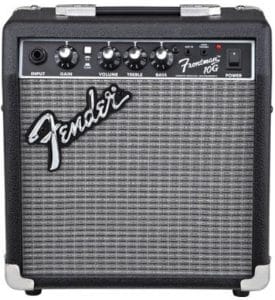
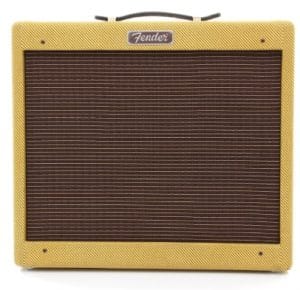
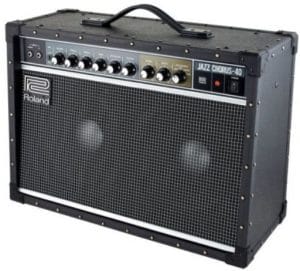
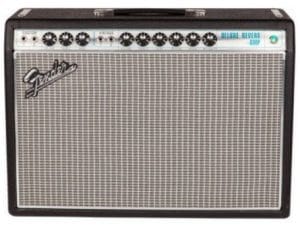
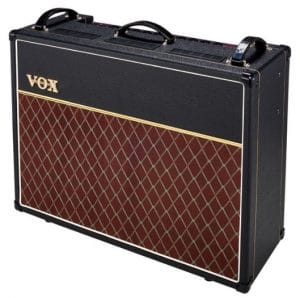
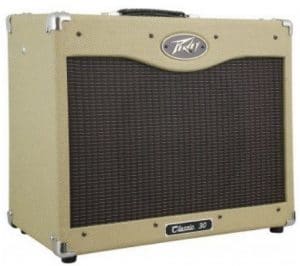
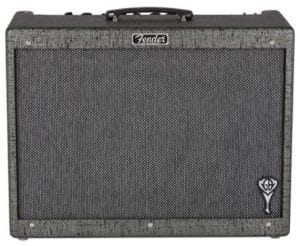


The Frontman 10G is the perfect little amp to begin with.
Fender’s smallest amp – the Frontman 10G is the perfect companion to begin your musical journey.